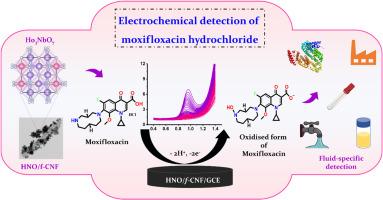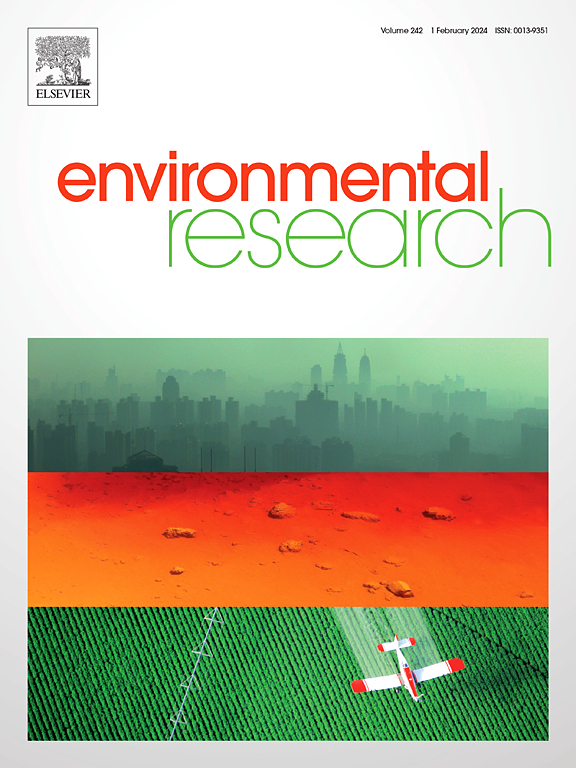利用稀土铌酸盐装饰的功能化碳纳米纤维传感器平台进行环境污染物盐酸莫西沙星的流体特异性检测
IF 7.7
2区 环境科学与生态学
Q1 ENVIRONMENTAL SCIENCES
引用次数: 0
摘要
开发精确高效的检测方法对于实时监测抗生素,尤其是环境和生物基质中的抗生素至关重要。本研究旨在通过引入一种新型电化学传感器来靶向检测第四代氟喹诺酮类药物盐酸莫西沙星(MFN),从而应对这一挑战。该传感器基于铌酸钬(HNO)和功能化碳纳米纤维(f-CNF)纳米复合材料,通过水热法合成,随后对其结构和电化学特性进行了表征。将 HNO/f-CNF 纳米复合材料沉积到玻璃碳电极 (GCE) 上后,通过循环伏安法 (CV) 和差分脉冲伏安法 (DPV) 对其进行了评估,结果表明其具有优异的电化学性能。该传感器具有出色的灵敏度,检测限为 0.034 μM,定量限为 0.11 μM,灵敏度为 0.69 μA μM-1 cm-2。它还实现了从 0.001 μM 到 1166.11 μM 的宽线性检测范围,使其在各种复杂基质(包括环境水体、生物液体和人工唾液)中实现了高效的中氟化氮检测,回收率在 98.15% 到 101.75% 之间。这项工作的新颖之处在于将 HNO 的催化特性和 f-CNF 的增强电子传输功能独特地结合在一起,建立了一个高选择性、高灵敏度的中氟苯检测平台。这种传感器不仅推动了电化学传感领域的发展,还为实时环境和药物监测提供了一种前景广阔的工具。本文章由计算机程序翻译,如有差异,请以英文原文为准。

Fluid-specific detection of environmental pollutant moxifloxacin hydrochloride utilizing a rare-earth niobate decorated functionalized carbon nanofiber sensor platform
The development of precise and efficient detection methods is essential for the real-time monitoring of antibiotics, especially in environmental and biological matrices. This study aims to address this challenge by introducing a novel electrochemical sensor for the targeted detection of moxifloxacin hydrochloride (MFN), a fourth-generation fluoroquinolone. The sensor is based on a holmium niobate (HNO) and functionalized carbon nanofiber (f-CNF) nanocomposite, synthesized via a hydrothermal approach and subsequently characterized for its structural and electrochemical properties. When deposited onto a glassy carbon electrode (GCE), the HNO/f-CNF nanocomposite demonstrated exceptional electrochemical performance, as assessed using cyclic voltammetry (CV) and differential pulse voltammetry (DPV). The sensor exhibited remarkable sensitivity, with a detection limit of 0.034 μM, a quantification limit of 0.11 μM, and a sensitivity of 0.69 μA μM−1 cm−2. It also achieved a broad linear detection range from 0.001 μM to 1166.11 μM, making it highly effective for MFN detection across various complex matrices, including environmental waters, biological fluids, and artificial saliva, with recovery rates between 98.15% and 101.75%. The novelty of this work lies in the unique combination of HNO's catalytic properties and f-CNF's enhanced electron transport, establishing a highly selective and sensitive platform for MFN detection. This sensor not only advances the field of electrochemical sensing but also offers a promising tool for real-time environmental and pharmaceutical monitoring.
求助全文
通过发布文献求助,成功后即可免费获取论文全文。
去求助
来源期刊

Environmental Research
环境科学-公共卫生、环境卫生与职业卫生
CiteScore
12.60
自引率
8.40%
发文量
2480
审稿时长
4.7 months
期刊介绍:
The Environmental Research journal presents a broad range of interdisciplinary research, focused on addressing worldwide environmental concerns and featuring innovative findings. Our publication strives to explore relevant anthropogenic issues across various environmental sectors, showcasing practical applications in real-life settings.
 求助内容:
求助内容: 应助结果提醒方式:
应助结果提醒方式:


